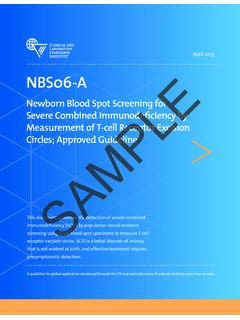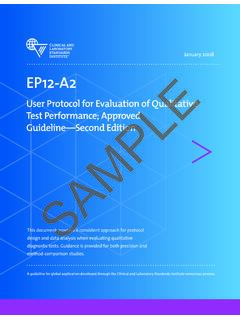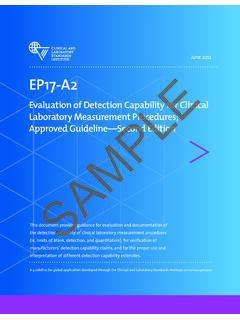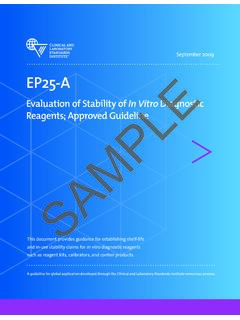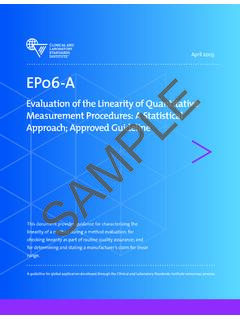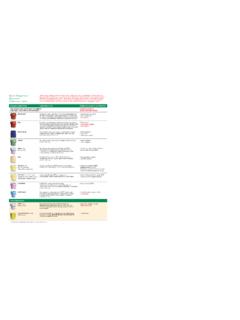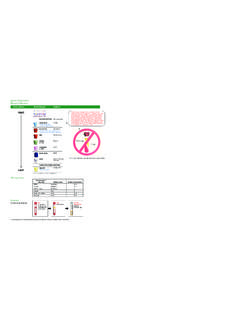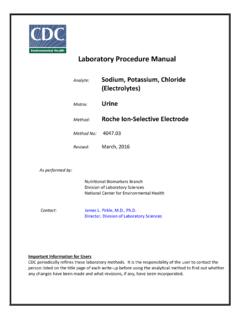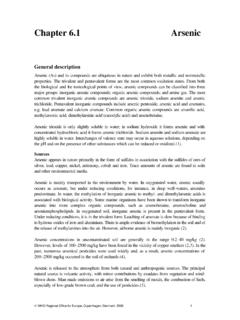Transcription of EP07-A2: Interference Testing in Clinical Chemistry ...
1 November 2005. EP07-A2. Interference Testing in Clinical Chemistry ;. E. Approved Guideline Second Edition PL. M. SA. This document provides background information, guidance, and experimental procedures for investigating, identifying, and characterizing the effects of interfering substances on Clinical Chemistry test results. A guideline for global application developed through the Clinical and Laboratory Standards Institute consensus process. Clinical and Laboratory Standards Institute Setting the standard for quality in Clinical laboratory Testing around the world. The Clinical and Laboratory Standards Institute (CLSI) is a not-for-profit membership organization that brings together the varied perspectives and expertise of the worldwide laboratory community for the advancement of a common cause: to foster excellence in laboratory medicine by developing and implementing Clinical laboratory standards and guidelines that help laboratories fulfill their responsibilities with efficiency, effectiveness, and global applicability.
2 Consensus Process Consensus the substantial agreement by materially affected, competent, and interested parties is core to the development of all CLSI documents. It does not always connote unanimous agreement, but does mean that the participants in the development of a consensus document have considered and resolved all relevant objections E. and accept the resulting agreement. Commenting on Documents PL. CLSI documents undergo periodic evaluation and modification to keep pace with advancements in technologies, procedures, methods, and protocols affecting the laboratory or health care. CLSI's consensus process depends on experts who volunteer to serve as contributing authors and/or as participants in the reviewing and commenting process. At the end of each comment period, the committee that developed the document is obligated to review all comments, respond in writing to all substantive comments, and revise the draft document as appropriate.
3 Comments on published CLSI documents are equally essential, and may be submitted by anyone, at any time, on M. any document. All comments are addressed according to the consensus process by a committee of experts. Appeals Process If it is believed that an objection has not been adequately addressed, the process for appeals is documented in the CLSI Administrative Procedures. SA. All comments and responses submitted on draft and published documents are retained on file at CLSI and are available upon request. Get Involved Volunteer! Do you use CLSI documents in your workplace? Do you see room for improvement? Would you like to get involved in the revision process? Or maybe you see a need to develop a new document for an emerging technology? CLSI wants to hear from you. We are always looking for volunteers. By donating your time and talents to improve the standards that affect your own work, you will play an active role in improving public health across the globe.
4 For further information on committee participation or to submit comments, contact CLSI. Clinical and Laboratory Standards Institute 950 West Valley Road, Suite 2500. Wayne, PA 19087 USA. P: F: EP07-A2. Vol. 25 No. 27. ISBN 1-56238-584-4 Replaces EP7-A. ISSN 0273-3099 Vol. 22 No. 27. Interference Testing in Clinical Chemistry ; Approved Guideline . Second Edition Volume 25 Number 27. Robert J. McEnroe, PhD. Mary F. Burritt, PhD. E. Donald M. Powers, PhD. Douglas W. Rheinheimer, MT. Brian H. Wallace, PhD. PL. Abstract M. Clinical and Laboratory Standards Institute document EP07-A2 Interference Testing in Clinical Chemistry ; Approved Guideline Second Edition is intended to promote uniformity in the evaluation of Interference characteristics of Clinical laboratory measurement procedures. EP07 describes procedures for manufacturers to screen potentially interfering substances, to quantify Interference effects, and to confirm Interference in patient samples.
5 This document also describes procedures for Clinical laboratories to verify Interference claims, and to investigate discrepant results caused by unsuspected interfering substances. Detailed examples are given. EP07 also contains background information on Interference Testing concepts, tables of SA. recommended test concentrations for analytes and potential Interference , and data collection and analysis worksheets. Clinical and Laboratory Standards Institute (CLSI). Interference Testing in Clinical Chemistry ; Approved Guideline Second Edition. CLSI document EP07-A2 (ISBN 1-56238-584-4). Clinical and Laboratory Standards Institute, 950 West Valley Road, Suite 2500, Wayne, Pennsylvania 19087 USA, 2005. The Clinical and Laboratory Standards Institute consensus process, which is the mechanism for moving a document through two or more levels of review by the health care community, is an ongoing process. Users should expect revised editions of any given document.
6 Because rapid changes in technology may affect the procedures, methods, and protocols in a standard or guideline, users should replace outdated editions with the current editions of CLSI documents. Current editions are listed in the CLSI catalog and posted on our website at If your organization is not a member and would like to become one, and to request a copy of the catalog, contact us at: Telephone: ; Fax: ; E-Mail: Website: Number 27 EP07-A2. Copyright 2005 Clinical and Laboratory Standards Institute. Except as stated below, any reproduction of content from a CLSI copyrighted standard, guideline, companion product, or other material requires express written consent from CLSI. All rights reserved. Interested parties may send permission requests to CLSI hereby grants permission to each individual member or purchaser to make a single reproduction of this publication for use in its laboratory procedure manual at a single site. To request permission to use this publication in any other manner, e-mail E.
7 Suggested Citation CLSI. Interference Testing in Clinical Chemistry ; Approved Guideline Second Edition. CLSI document August 1986. Approved Guideline December 2002. PL. EP07-A2. Wayne, PA: Clinical and Laboratory Standards Institute; 2005. Proposed Guideline Approved Guideline Second Edition M. November 2005. SA. ISBN 1-56238-584-4. ISSN 0273-3099. ii Volume 25 EP07-A2. Contents Abstract ..i Committee iii Foreword .. vii 1 Scope .. 1. 2 Introduction .. 1. Measurement Procedures .. 1. Concepts and Scientific 2. E. 3 Standard Precautions .. 4. 4 Definitions .. 5. 5 Decision Criteria for Interference Testing .. 8. 6. PL. Clinical Acceptability Criteria .. 9. Statistical Significance and Power .. 9. Analyte Test Concentrations .. 10. Potential Interfering Substances .. 10. Interferent Test 11. Quality Assurance and Safety .. 12. Training and 12. M. Precision Verification .. 12. Trueness Verification .. 12. Carryover Assessment .. 12.
8 Quality Control .. 12. Safety and Waste 13. 7 Estimation of Interference Characteristics .. 13. SA. Interference Screen .. 13. Characterization of Interference Effects .. 20. Evaluating Combinations of Analyte and Interferent(s) .. 26. 8 Evaluating Interference Using Patient Specimens .. 26. Experimental 26. Comparative Measurement Procedure .. 27. Patient Populations .. 27. Experimental Procedure .. 28. Data Analysis .. 28. Interpretation of 31. 9 Establishing, Validating, and Verifying Interference Claims .. 31. Establishing Interference Claims .. 32. Verifying Analytical Specificity .. 34. Validating Analytical Specificity .. 35. Verifying Interference and Specificity Claims .. 36. v Number 27 EP07-A2. Contents (Continued). 10 Investigating Discrepant Patient 36. Verify System Performance .. 37. Evaluate Sample Quality .. 37. Confirm the Original 37. Identify Potentially Interfering Substances .. 38. Determine the Probable Interferent.
9 38. Characterize the Interference .. 39. References .. 40. Appendix A. Guidelines for Specific Measurement Procedures .. 43. Appendix B. Analyte Test Concentrations .. 46. E. Appendix C. Interferent Test Concentrations .. 49. Appendix D. Interference Test Concentrations for Endogenous Analytes .. 75. PL. Appendix E. Worksheets .. 79. Appendix F. Calculation of Replicates for Dose-Response Tests .. 87. Appendix G. Preparation of Test Solutions for Interference Testing .. 90. Summary of Consensus Comments and Committee Responses .. 96. Summary of Consensus/Delegate Comments and Committee Responses .. 101. M. The Quality System Approach .. 104. Related CLSI/NCCLS Publications .. 105. SA. vi Volume 25 EP07-A2. Interference Testing in Clinical Chemistry ;. Approved Guideline Second Edition 1 Scope This document is intended to serve two purposes: 1) to assist manufacturers and other developers of laboratory measurement procedures in characterizing the susceptibility of measurement procedures to interfering substances, by offering scientifically valid experimental designs, by specifying the relevant substances and concentrations to be tested, and by clarifying appropriate data analysis and interpretation, so that potential hazards can be evaluated and meaningful Interference claims may be provided to users; and E.
10 2) to assist Clinical laboratories in investigating discrepant results due to interfering substances, by defining a systematic investigation strategy, by specifying data collection and analysis requirements, and by promoting greater cooperation between laboratory users and manufacturers, so that new interferences can be identified, disclosed, and ultimately eliminated. PL. This guideline is intended for manufacturers of in vitro diagnostic medical devices and Clinical laboratories. Manufacturers and other developers of laboratory measurement procedures are responsible for characterizing the analytical performance of their procedures and analyzing hazards to patients caused by errors due to interfering substances. Manufacturers are required to provide information about Interference susceptibility to those who use their systems. NOTE: The term manufacturer, for the purpose of this document, is used to mean anyone that develops a measurement procedure for use in a Clinical laboratory.
